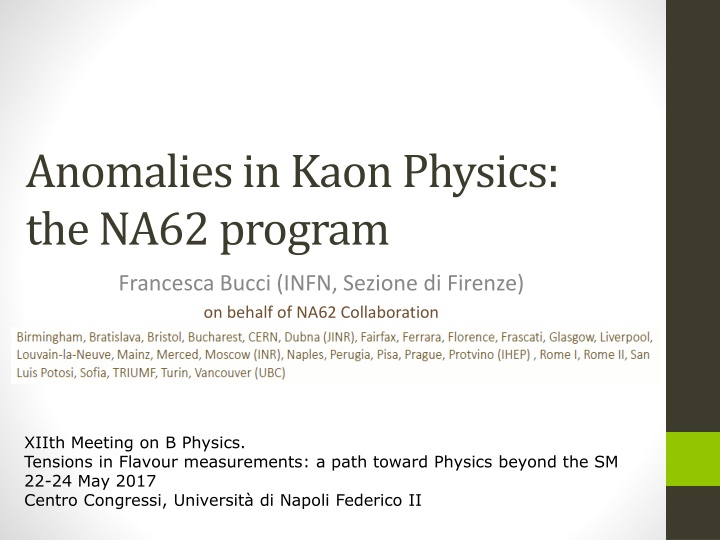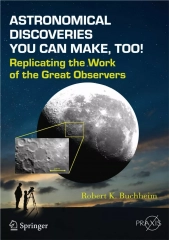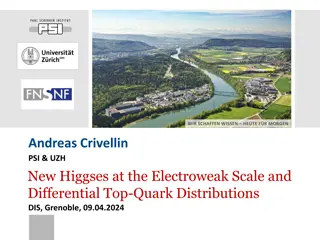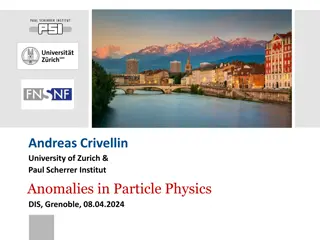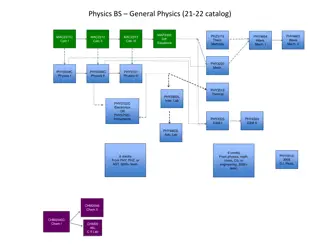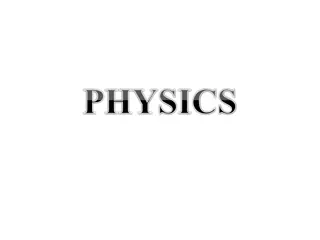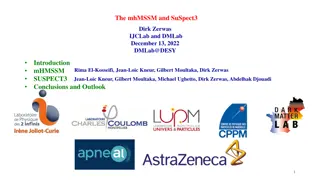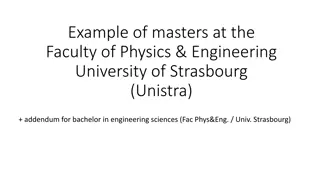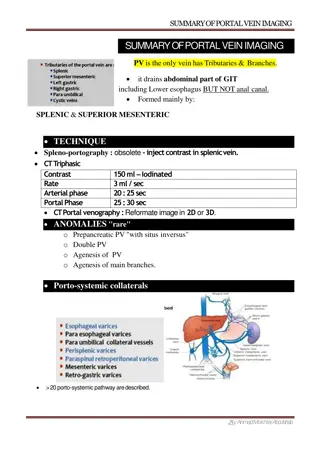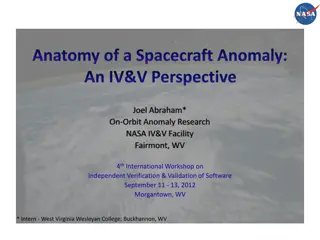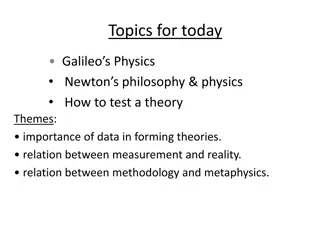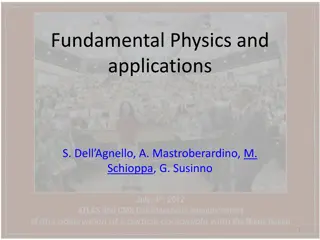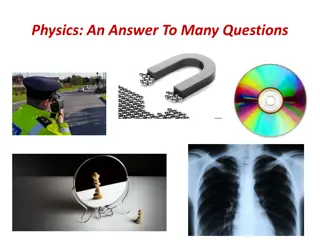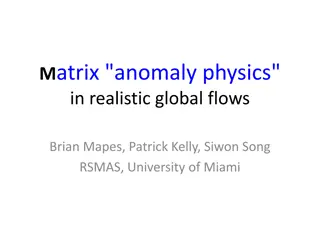Insights into Kaon Physics: Unraveling Anomalies and New Discoveries
Delve into the world of Kaon Physics, from the historical discoveries like CP violation to modern experiments testing fundamental symmetries. Explore anomalies challenging the Standard Model and the implications for new physics models. Discover the interplay of QCD and EW penguin contributions, uncertainties in branching ratios, and the quest for understanding Flavour Changing Neutral Current processes in the realm of Kaon physics.
Download Presentation

Please find below an Image/Link to download the presentation.
The content on the website is provided AS IS for your information and personal use only. It may not be sold, licensed, or shared on other websites without obtaining consent from the author.If you encounter any issues during the download, it is possible that the publisher has removed the file from their server.
You are allowed to download the files provided on this website for personal or commercial use, subject to the condition that they are used lawfully. All files are the property of their respective owners.
The content on the website is provided AS IS for your information and personal use only. It may not be sold, licensed, or shared on other websites without obtaining consent from the author.
E N D
Presentation Transcript
Anomalies in KaonPhysics: the NA62 program Francesca Bucci (INFN, Sezione di Firenze) on behalf of NA62 Collaboration XIIth Meeting on B Physics. Tensions in Flavour measurements: a path toward Physics beyond the SM 22-24 May 2017 Centro Congressi, Universit di Napoli Federico II
Kaon Physics: a Building Block of the SM Discovery of strange particles: first observation of a quark-flavour not present in the ordinary matter [Nature 160 4077 (1947) 855] Postulation of neutral meson oscillation [Phys. Rev 97 (1955) 1387] - puzzle: first hint of P violation [Phys. Rev. 104 (1956) 254] Discovery of CP violation in the K0 mixing [Phys. Rev. Lett. 13 (1964) 138] 3-quark-model to describe the observed meson/baryon spectra [Phys. Lett. 8 (1964) 214] Prediction of the c-quark to explain the unexpectly low observed branching ratio of decay the KL + - [Phys. Rev. D 2 (1970) 1285] First evidence of direct CP violation in the K0 [Phys. Lett. B 206 (1988) 169] F.Bucci 2
Kaon Physics: Toward the Present Era Kaon Experiments [1995-2010] NA48 (CERN), KTeV (FNAL), KLOE (LNF), CPLEAR (CERN), E865 (BNL), ISTRA+ (Protvino) F.Bucci Measurement of direct CP violation in the K0 (NA48@CERN, KTeV@FNAL) [Phys. Lett. B 544 (2002) 97, Phys. Rev. D 83 (2010) 092001] Test of CPT symmetry invariance [K.A. Olive et al. (Particle Data Group, Chin. Phys. C, 38, 090001 (2014)] Precision test of the CKM unitarity [Eur. Phys. J. C 69 (2010)] Test of lepton universality [Phys. Lett. B 719 (2013) 326] 3
Anomalies in Kaon Physics: / one of the important actors of 1990s particle physics Strong interplay of QCD and EW penguin contributions New results on hadronic matrix elements of QCD and EW penguin operators leads to a prediction in the SM significantly below experimental data. F.Bucci ' ' ( ) ( 9 . 1 ) = 3 . 2 4 = 5 . 4 4 16 6 . 10 10 Exp Th Buras, Gorbahn, Jager, Jamin ArXiV 1507.06345 World average from NA48 and KTeV 3 discrepancy Impact on various NP models: in particular models where there is a strong correlation between / and the branching ratio for K+ + and KL 0 4 Z general (Buras, Buttazzo, Knegjens, 1507.08672), Littlest Higgs Model (Blanke, Buras, Recksiegel, 1507.06316), 331 Models (Buras, De Fazio, 1512.02869, 1604.02344)
K in the SM Flavour Changing Neutral Current process forbidden at tree level in the SM F.Bucci Highest CKM suppression very sensitive to New Physics Theoretical uncertainties at the level of 2% in BR but significant parametric uncertainties due to |Vub|, |Vcb| and [Buras et al. arXiv:1503.02693], [Brod et al. Phys. Rev. D 83,034030 (2011)] 2.8 0.74 V ( ) ( ) + + 11 11 cb = = BR K (8.39 0.30) 10 8.4 0.6 10 0.0407 73.2 2 2 2 V V ( ) sin ( ) 11 11 ub cb = = 0 BR K (3.36 0.05) 10 3.4 0.6 10 5 L 0.00388 0.0407 sin 73.2
and beyond the SM Pattern of correlation between BR(K+ + ) and BR(KL 0 ) discriminates among models Z model [A. J. Buras, F. De Fazio and J. Girrbach JHEP 1302 (2013) 116] F.Bucci Randall-Sundrum [JHEP 0903 (2009) 108] Littlest Higgs [Acta Phys. Polon. B41 (2010) 657] 6
The long K march First search: 1969 (10-4) Observation: 1997 (10-10) KL 0 K+ + F.Bucci KOTO KOTO NA62 7 ( ) ( = ) + + + . 1 . 1 15 05 10 BR K . 1 73 10 [Phys. Rev. D77, 052003 (2008), Phys. Rev. D79, 092004 (2009)]
The NA62 Experiment for K++ SPS proton 400 GeV 1012p/s 3.5 s spill F.Bucci Secondary Beam Decay region 75GeV/c, p/p 1% Fiducial region 60 m length K+ decay rate 5 MHz Momentum Divergence (RMS) 100 rad Composition K(6%), (70%), p(23%) Nominal rate 33 1011 (750 MHz at GTK3) Transverse size 60 30 mm2 8 O(10-6)mbar Vacuum
The NA62 Status 2014 Pilot run 2015 Commissioning run 2016 Commissioning + Physics run F.Bucci 2016 Run 07/05-22/07 Detector commissioning 23/07-13/09 Final Commissioning /L1 trigger, GTK) Physics (exotics, rare/forbidden decays) 16/09-03/11 Physics ( , exotics, rare/forbidden decays) 9
Analysis NA62 goal : K+ + BR measurement with O(10%) precision O(10%) Signal acceptance O(5/1) Signal/Background On disk ( period, 60m fiducial volume) 13 1011ppp on T10 (40% of nominal) F.Bucci Intensity and DAQ capability depend on spill quality 10 2016 Analysis goal : assess the sensitivity at the level of 10% In the next slides a preliminary exploratory analysis shown ( 5% of 2016 data)
Analysis Strategy Signal signature: Incoming K+ Outgoing + in time with the K+ Nothing else Background: K+ + 0 0.2066 K+ + 0.6356 K+ + - + 0.0558 F.Bucci Analysis tools: Precise kinematic reconstruction ( )2 K miss P P m = 2 PID: K upstream, e/ / downstream Hermetic detection Sub-ns timing 11
Selection NA62 Keystone O (100 ps) Timing between sub-detectors O(104) Background suppression from kinematics > 107 Muon suppression > 107 0 (from K+ + 0 ) suppression F.Bucci K+ Decay Event Fiducial Decay Region Particle ID Photon Rejection Multiple charged particle rejection 12 Kinematic selection of the signal regions
Kaon Decay Selection Single + topology Kaon ID in KTAG K - matching + timing: (TCHOD) 250 ps, (TRICH) 100 ps K+timing: (TKTAG) 80 ps, (TGTK) 100 ps Closest distance of approach between GTK and Straw track TGTK-TKTAG F.Bucci (CDA) 1.5mm 13 Mis-tagging probability: 1.7% [40% nominal intensity, 75% efficiency]
Fiducial Decay Region Origin of Kaon Decays Events K+ decays downstream GTK3 K+ interactions in GTK3 K+ decays upstream GTK3 early decays F.Bucci Fiducial Decay Region 110/115 < Zvertex < 165 m lower limit against early decays CHANTI against interactions in GTK3 14
Kinematics F.Bucci 15
Signal and Background Regions To control non gaussian tails from mis-match and mis-measurements m2miss resolution F.Bucci compute the missing mass also with RICH indipendently from STRAW with nominal K momentum design value reached : 10-3 GeV4/c2 16
Particle ID Samples of and from K+ + 0 and K+ + selected kinematically Combined efficiency PID with calorimeters ID efficiency 80% mis-ID probability 10-5 F.Bucci PID with RICH ID efficiency 80% mis-ID probability 10-2 Efficiency of ring reconstruction 90% [depends on p ] 17 RICH, calorimeter independent Performances improvement expectd
Photon Rejection To measure rejection, consider events left in the K+ + 0 region after the selection Before -rejection minimum bias, D=400 After -rejection PNN trigger F.Bucci accidental losses measured on K+ + events passing signal selection with photon veto PNN n = (1.2 0.2) 10-7 18 = 0 control control D N Events in control trigger passing the signal selection but the photon veto downscale factor of control trigger
Expected Signal and Background in 5% of 2016 statistics 85% (preliminary) measured on data BR A = 0.064 = exp control control trig N D N BR A Normalization: K+ + 0 cfrom control trigger data passing the signal selection but the photon rejection F.Bucci Acceptance: ratio between signal and normalization: 0.60/0.86 N (K decays) 2.3 1010[5% of 2016 statistics] acceptance 0.033 Process Expected Events Branching ratio K+ + 0 0.024 0.2066 K+ + 0.011 0.6356 K+ + - + 19 0.017 0.0558 Early decays < 0.005 K+ + - + suppression very preliminary
K++ Result No events in signal region F.Bucci 20 Event in box has m2miss (no GTK) outside the signal region
NA62 Physics besides K++ The high-intensity and high-performance setup make NA62 suited for other NP searches Exotic searches Dark Photons (A ), Heavy Neutral Leptons (HNL), Axion-like particles (ALP) F.Bucci Rare/Forbidden Decays K+ +l+l- [O(10-7)] , 0 e+e- [BR=6.46 10-8] K+ +l1+l2-, K+ l1- l1+l2- (l1,2= e, ), K+ + e+, 0 e+ 21
Invisible Vector from 0 decay K+ + 0, 0 A , A invisible N(K decays) 1.5 1010 ( 4% 2016 statistics) F.Bucci mA (GeV) 22
Conclusions Kaons ? New Physics could be already there: ? NA62 fully working Good 2016 run 5 1011 kaon decays taken in the last 40 days goal: test sensitivity down to 10-10 First preliminary results on K+ + (5% data) are promising analysis of the full 2016 data set in progress optimization/improvement of the analysis in progress F.Bucci 23 Excellent prospects for a broader physics program
RK Final Result RK= (2.488 0.010) 10-5 Fully exploit kinematics and strong particle ID Main background from K 2 10 improvement, consistent with SM F.Bucci NP potential still open NA62 prospects: expected uncertainty 0.2% (more statistic, more hermetic vetoing, better resolution and PID) TREK stopped K proposal: expected uncertainty 0.25% 25 KLOE (2009) 14K events, 16% bkg NA62 (2013) 146K events, 11% bkg
KL00 The charm contribution can be fully neglected since it proceeds in the SM almost entirely through direct CP violation determination of Exp Machine Meas. or UL 90% CL Notes F.Bucci <5.7 10-7( 0 ee ) KTeV Tevatron <2.6 10-8 E391a KEK-PS KOTO J-PARC Aim at 2.7 SM evts/3y Need a huge number of KLdecays NA48 KLflux corresponding to 3 1010/year NA62 possible KLflux 5-10 times NA48 one After SPS upgrade 100 times more 26
Anomalies in Kaon Physics: K Ms,d Tension New results from Fermilab Lattice and MILC collaboration ( ) MeV 5 . 8 0 . 276 = S S B B B F ( )MeV = 3 . 9 229 4 . F B B B d d Construct the UUT (CMFV) by using only M , Blanke, Buras 1602.04020 F.Bucci V d s , ub and derive K s M S V cb Strategy 1: Ms determines Vcb |Vcb| = (39.5 1.3) 10-3 Strategy 2: K determines Vcb |Vcb| = (39.5 1.3) 10-3 Tension between Ms and K 27 Impact on the branching ratio of K+ + and KL 0
